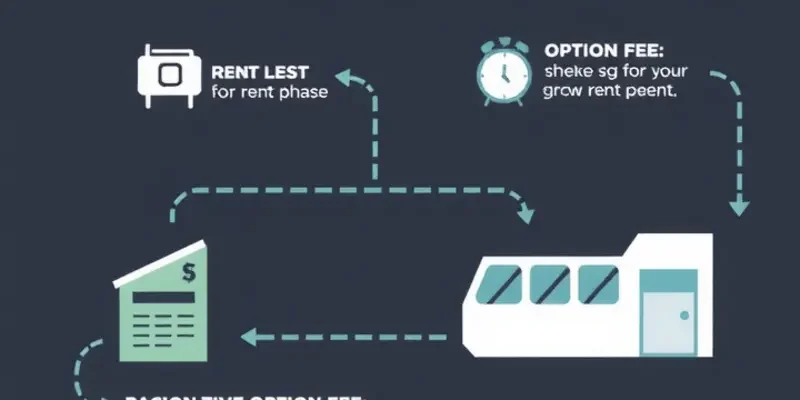Let’s face it, the idea of homeownership can sound as daunting as building a spaceship in your garage. For many young adults—first-time renters, fresh-out-of-college career climbers, newly hitched couples, or growing families—the traditional home-buying process is riddled with mountain-high down payments, credit score anxiety, and endless paperwork. But wait! There’s a nifty solution that allows you to tiptoe into homeownership without breaking the bank all at once: rent-to-own homes! It’s like dipping your toes into the water before taking the full plunge. With a rent-to-own arrangement, you can live in the home, get to know it, and build equity while you’re at it! So, how does this work and why should you consider it? Grab your coffee! We’re diving into the world of rent-to-own homes that cater specifically to you, the modern-day home seeker.
The What and How of Rent-to-Own Homes

Rent-to-own agreements bridge the gap between renting and homeownership, offering a unique path for potential buyers. Understanding this process requires unraveling the complexities that make it a viable option for many. Essentially, a rent-to-own agreement consists of two main phases: the rental period and the eventual purchase. During the rental phase, you pay a monthly rent, just like a traditional tenancy. However, part of this payment might go toward your future home purchase. Here’s where understanding the contract is crucial; not all agreements allocate these ‘rent credits’ in the same way.
Once the initial rental term concludes, typically lasting from one to three years, you’ll have the option (but not the obligation) to purchase the home. The contract’s purchase agreement will specifically lay down terms like the future sale price agreed upon at the outset. This aspect can be advantageous in a rising market where property values tend to climb over the years.
It’s critical to examine the common types of rent-to-own agreements: lease-option and lease-purchase. With a lease-option, you’re not obligated to buy the house at the end, offering you more flexibility. A lease-purchase, however, legally binds you to buy the home once the lease term ends. Scrutinize these terms and contemplate your long-term plans before locking yourself into a lease-purchase contract.
A meticulous review of each clause in your agreement is essential. Pay particular attention to maintenance responsibilities, as some contracts may shift certain obligations to you. It’s wise to have an emergency fund on hand for potential repairs or unexpected issues. And, of course, always verify if your agreement complies with local laws by consulting a legal expert.
Ensure you don’t sacrifice more than necessary. Look through your budget to identify where you might be prone to overspending. If rent-to-own commitments seem daunting, consider exploring budgeting strategies. Check out budgeting tools for renters to help you balance monthly expenses efficiently.
Avoid common pitfalls that come with inexperience. Before signing, verify the property’s market value and compare it to the purchase price in your agreement. Overpaying is easy when emotions run high with dreams of homeownership. Address existing liens on the property and ensure all taxes are current. A title search can save you future headaches.
In closing, patience and diligence are your best allies in the rent-to-own journey. Whether considering a bungalow or a city loft, awareness and planning will help you enjoy the benefits without the risk of lifelong financial stress.
The Pros and Cons: Is Rent-to-Own Right for You?

Navigating the world of rent-to-own agreements can feel like a balancing act. On one side, the allure of stepping into homeownership without the immediate financial plunge is enticing. On the other, hidden challenges may tip the scales. This chapter sheds light on both aspects, helping you weigh your options effectively.
The Pros
For young professionals dreaming of owning a home yet wary of the financial commitment, rent-to-own is a promising avenue. It allows you to live in your prospective home while saving for its purchase. This arrangement lets you test-drive your future residence, ensuring it meets your lifestyle needs. Additionally, a portion of your monthly rent often contributes to the down payment, creating a savings mechanism without extra effort.
Rent-to-own agreements can be a boon for those with less-than-perfect credit. They provide time to improve your financial standing while securing a desirable property. As rents paid today may not fully reflect escalating market prices, locking in a purchase price now is another advantage.
For families seeking expansion, rent-to-own homes offer space without the pressure of immediate ownership. It grants time and opportunity to transition from renting to owning seamlessly, without uprooting children from schools or disrupting routines during the move.
The Cons
Yet, every silver lining has its cloud. These arrangements may entail a higher rent compared to typical lease agreements. It’s crucial to be financially prepared for this increased outlay, knowing it’s an investment toward ownership. Carefully scrutinize your contract for additional charges and fees that may dampen your budget over time.
Unexpected home maintenance costs can arise. Unlike typical rentals where landlords handle repairs, some rent-to-own agreements shift this responsibility to the tenant. Ensure you understand who covers what before signing.
Understanding your contract is paramount. Before committing, consult legal advice to mitigate the risk of unfavorable terms. A poorly structured agreement might not guarantee a successful purchase at the end of the lease. If the market for property values declines, you could end up owing more than the home is worth.
Finally, consider your long-term plans. If career or personal circumstances might prompt a move, the flexibility of renting might be more suitable. Rent-to-own arrangements often include non-refundable fees, which could be costly if you decide against purchasing.
For those ready to dive deeper into lease terms and potential pitfalls, exploring impactful questions to guide your decision can help. Check out this comprehensive guide on apartment contract questions to navigate contractual complexities effectively.
In conclusion, the path to homeownership through rent-to-own agreements is a viable option, albeit with caveats. Weighing the benefits against the drawbacks is crucial to ensure it aligns with your life goals and financial capacity. Armed with this knowledge, you’ll be better positioned to unlock the door to your future home, complete with its unique challenges and rewards.
Final words
Rent-to-own homes present an exciting opportunity for many young adults and families looking to break into the world of homeownership. By understanding how these agreements work, weighing the pros and cons, and doing your homework, you can make a move that feels right for you. Whether you dream of backyard barbecues or simply having the freedom to paint your walls without asking a landlord, rent-to-own can offer a bridge to your dream. So, gather your notes, research wisely, and dive into the journey of homeownership—your future cozy nook or stylish flat awaits!









